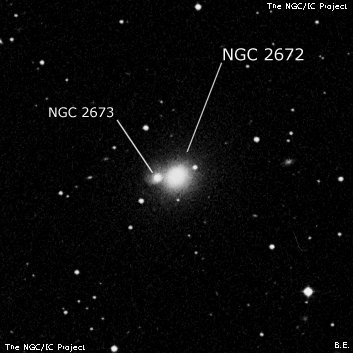
William Herschel discovered NGC 2672 = H II-48 = H II-80 = h526 on 14 Mar 1784 (sweep 169) and recorded "a nebula r[esolvable], pL, lbM then towards the extremes and contains one star following the brightness and very near to it." His position is off by nearly 15' (the reference star was a large distance away) and the nearby star he mentions is the close companion NGC 2673. Dreyer noted in his 1912 publication of WH's catalogues, that "there was some doubt about the contraction of the rope in Sw. 169, hence in the error in the P.D. of II.48." One week later he recorded II-80 on sweep 181 as "pB, pL, E, r. I can see 2 or 3 stars in it." In this sweep his position was accurate to within 2', so the identification is certain. Another observation of II-80 was on 13 Feb 1787 (sweep 698): "pB, E from a few degrees sp to nf. The greatest brightness lays to the preceding side, it resembles a small one with another much smaller close to it nf NGC 2673] with resolvable nebulosity around it." In this sweep he mentioned he looked for II-48, but couldn't find it.
Coincidentally, John Herschel discovered a very faint galaxy (h527 = NGC 2677 = CGCG 090-021) on 17 Mar 1831 that he assumed was his father's H. II-48. On 19 Dec 1848, George Stoney discovered NGC 2673, a close companion to NGC 2672 -- noted as a star by both Herschels -- with LdR's 72", but he thought it was h527. In the GC, JH still listed H II-48 under the entry for NGC 2677 (GC 1707). Finally, in the GC Supplement, Dreyer suggested II-48 = II-80 and they were equated in the NGC.
300/350mm - 13.1" (1/18/85): moderately bright, slightly elongated ~E-W, bright core.
13.1" (1/28/84): fairly faint, small, round.
400/500mm - 17.5" (1/28/89): moderately bright, fairly small, slightly elongated, sharp concentration. Forms a contact pair with NGC 2673 at the east edge 40" separation between centers. A mag 13.5 star is 1.5' NNE and a fainter mag 14 star is 1.1' SE.
600/800mm - 24" (2/16/15): bright, fairly large, sharply concentrated with a very bright core. The large halo (~1.6' dia) has a low surface brightness and appears to encompass NGC 2673 (just 35" between center). A mag 14 star lies 1.2' SE and a mag 13.7 star is 1.6' NE. A mag 15 star is embedded on the west edge of the halo [34" from center]. At 450x, the core gradually brightens to a quasi-stellar nucleus.
Notes by Steve Gottlieb